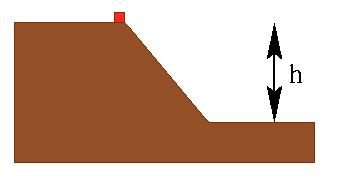Question 07/99
MISSING ENERGY
 A body starts sliding (from rest) without friction down a
hill of height h. In the beginning the body has potential
energy and no kinetic energy; at the end the body has only kinetic
energy.
It follows from energy conservation,
mgh=½mv2, that the velocity of the body
at the bottom of the hill will be v=(2gh)1/2.
A body starts sliding (from rest) without friction down a
hill of height h. In the beginning the body has potential
energy and no kinetic energy; at the end the body has only kinetic
energy.
It follows from energy conservation,
mgh=½mv2, that the velocity of the body
at the bottom of the hill will be v=(2gh)1/2.
Now consider the same process from a reference frame moving with
velocity v (to the right) relative to the ground. In this
reference frame, the body in the beginning has potential energy
mgh and kinetic energy (1/2)mv2, while
at the end of the process both energies vanish. Where did the
energy disappear? Give a detailed account of missing energy!
 Back to "front page"
Back to "front page"
 A body starts sliding (from rest) without friction down a
hill of height h. In the beginning the body has potential
energy and no kinetic energy; at the end the body has only kinetic
energy.
It follows from energy conservation,
mgh=½mv2, that the velocity of the body
at the bottom of the hill will be v=(2gh)1/2.
A body starts sliding (from rest) without friction down a
hill of height h. In the beginning the body has potential
energy and no kinetic energy; at the end the body has only kinetic
energy.
It follows from energy conservation,
mgh=½mv2, that the velocity of the body
at the bottom of the hill will be v=(2gh)1/2.
 Back to "front page"
Back to "front page"